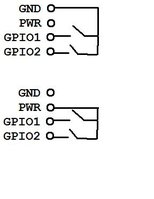Most of the pads on OMAP3530 have the option for internal pullup or pulldown. You want to configure the GPIO for internal pullup and connect the switch to ground. When the switch is open it'll be pulled up and read 1, and when it's closed it'll short to ground and read 0.
You might expect for the pullup/pulldown configuration to happen in the GPIO setup, but since it's tied to physical pads it's done in the system control module. You want to look for the register CONTROL_PADCONF_X that corresponds with the GPIO block you want. For instance, let's say you're using GPIO 147 on pin 1 of the ext connector. To set this up you need to use CONTROL_PADCONF_UART2_TX. You can see on page 775 of the reference manual that GPIO 147 is set as mux mode 4 on this pin. So you'll want to set the low 3 bits to 4 to set this mux mode, set PULLUDENABLE to 1, PULLTYPESELECT0 to 1, INPUTENABLE0 to 1, OFFENABLE0 to 0, and WAKEUPENABLE0 to 0. I think that should be it.
Then you have to set the GPIO control. Set bit 19 in GPIO_OE bank 5 to 1.
The one caution is that if this pad is somehow set as output and driven (instead of pulled) you'll have a problem because there'll be a short, which could result in damage if there isn't enough impedance elsewhere to catch it. The pin I picked is normally set for UART RX so you'd think this wouldn't happen (in other words, don't pick something that has a normal use case as an output). If in doubt you can prevent damage by pulling the switch down to ground instead of connecting directly to it. You would have to use a pull down resistance value that is substantially less than the internal pull up value, in order for it to be sure to override it. The internal pull up drives 100 uamps at 1.8V, so it's 18KOhm resistance. An order of magnitude less (say, around 2K) should be sufficient.
Failing that, make sure that the register configuration is right before connecting anything to it.


